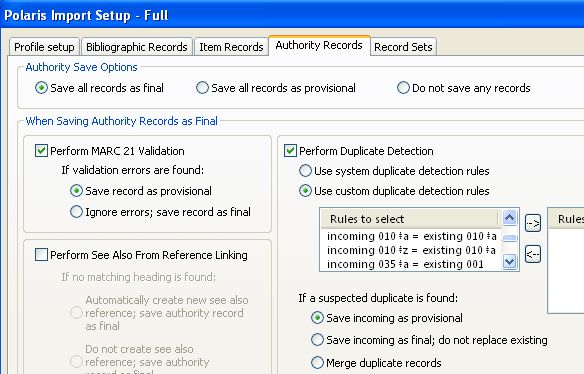Definition:
Blind References: A subject, name or series title authority record contains a blind reference if there is no heading in the database corresponding to the valid form stored in the authority file. Usually the last bibliographic record that contained the heading has been deleted. These authority records are to be deleted from your ILS system authority file.
On a library’s ILS system the blind reference will either not be included in the authority index or will be included in the index with zero hits (bibliographic connections) associated with it. When an authority file is in place on an ILS system only the authorized heading 1XX or the see also reference 5XX of the authority record can be a blind reference. The nature of the see reference 4XX always points to the authorized heading 1XX and can not be a blind reference though on some ILS systems a search on the see reference will have the same result as a search on the authorized heading if the authority record is a blind reference. That is no bibliographic record will be found.
Example of a Blind Reference: Note the 0 that is in yellow is a blind reference. The other 0 under Topographic Brain mapping is a see reference.
Subject Titles
Topographic maps – Databases. 2
Topographic maps — Databases — Software. 0
Topographic maps — Software. 2
How a Blind Reference gets on a Library’s ILS system
There are several ways an ILS system produces Blind References. The following is a list of a few.
1. If a library deletes the last bibliographic record associated with an authority it will become a blind reference unless it is removed from the system.
2. If a new authority does not match up to an existing authorized bibliographic heading it will become a blind reference.
3. If an authority automation vendor delivers an authority that the library no longer owns it will become a blind reference.
The first description of how a blind reference gets on a library system can be avoided by making sure that you delete any authority associated with a deleted bibliographic record. Most ILS systems automatically generate a report of these occurrences.
The second blind authority problem occurs during the automation authority control process. In the past these had to be reconciled or connected through a semi automated and sometimes time consuming process. Backstage now has a process called “Heading Tracker” that makes manual reconciliation almost obsolete.
The last blind authority problem also occurs during the automated authority control process but can be easily remedied by routine maintenance described below.
Maintenance:
The library needs to send their authority deletes to their automation vendor. There is no automatic removal from the master authority file your vendor keeps with the library’s authority database. The process can be part of a simple routine maintenance. Most ILS systems automatically generate a file of deleted authority records that can be accessed through reports. If a list of the deleted records is sent to Backstage we can remove them from your master authority file. That list should include the control number (001) of the authority record.
